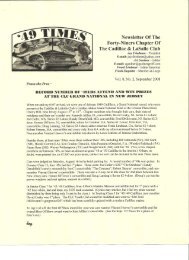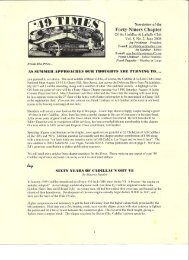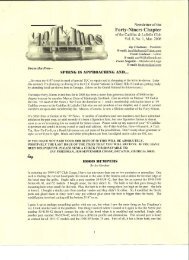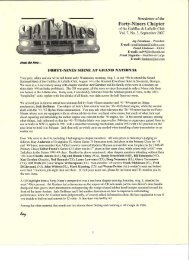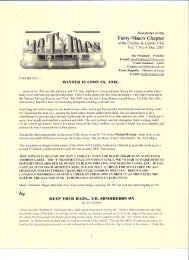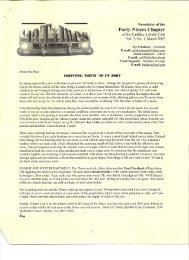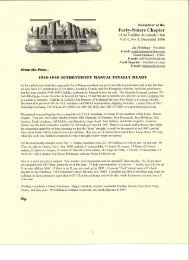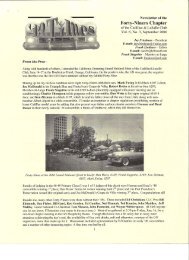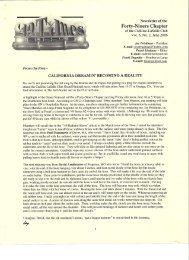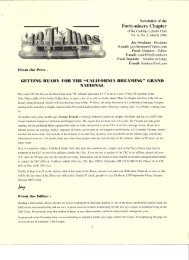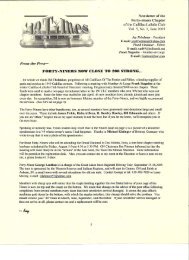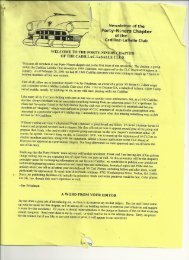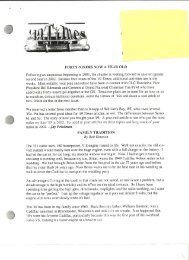Create successful ePaper yourself
Turn your PDF publications into a flip-book with our unique Google optimized e-Paper software.
As shown in the drawing below, loosely screw on the large steering wheel hold-down nut the until most or all of its threads<br />
have engaged the steering shaft, but with some space still remaining between the bottom of the nut and the steering wheel hub.<br />
At the same time, make sure the two “half-moon” slots are lined up with the threaded holes in the steering wheel hub. Then,<br />
starting with the 1 inch pair, screw two of the washer-head bolts past the “half-moon” slots and into the threaded holes in the<br />
steering wheel hub until the washer heads are snug against the large steering wheel nut.<br />
Now, using a wrench, slowly and carefully tighten the washer-head bolts, each one a fraction of a turn at a time, so that neither<br />
bolt puts more pressure on the nut than the other. Advantageously, this works by putting force on the large threads of the<br />
steering column shaft, instead of on the end of the shaft (where it could damage the horn contact).<br />
As I did, you may find that you will have to exchange the first pair of washer-head bolts for a shorter pair as the steering wheel<br />
is pulled up. You may also find that you‟ll have to unscrew the large steering wheel nut one or more turns to create more space<br />
between it and the steering wheel hub. When the steering wheel breaks loose, you may or may not hear a snapping or popping<br />
noise. Like the 3 guys lowering the engine in the factory photo on page 3, “Easy does it”.<br />
MY 6107<br />
By Jay Friedman<br />
Since photos and descriptions of many members‟ cars have appeared in the Times over the years, I thought that as my “swan<br />
song” I would exercise my prez-idential privileges to show off my own 6107 2-door club coupe, “The Green Queen”. She‟s a<br />
“late” car, built Oct. 20, 1949 and sold by Rickenbaugh Motors in Denver. (This Cadillac dealer is still in existence and<br />
participated in the Grand National in that city in 2001.) In 1974 The Queen went from the original owner to two antique car<br />
dealers in Colorado in quick succession, one of whom replaced the original Madeira Maroon paint with a generic dark green.<br />
The second dealer sold it in 1975 to a lady in Laramie, Wyoming who, 2 years later, sold it to a collector in the Chicago area. I<br />
bought it from him via an ad in Hemmings in Sept. 1984 for $5,200. („49s were cheaper in those good old days.) It had been<br />
undercoated when new, so was practically rust-free and, though it ran well, was a bit worn cosmetically and mechanically.<br />
I had the motor rebuilt in 1985 and had it re-painted in 1986 another dark green (close to Dartmouth Green, a ‟49 color). The<br />
next year I had the original worn-out Series 61 upholstery replaced. In 1988, The Queen appeared in the opening scenes of the<br />
film “Driving Miss Daisy”, filmed in our Atlanta neighborhood. It played the role of the car of the character Boolie, Miss<br />
Daisy‟s son, who was played by Dan Akroyd. In one scene Mr. Akroyd drove the car, with Morgan Freeman, who played the<br />
character Hoke, as his passenger. If there was such a thing, it surely would have received an Academy Award as “Best Car”.<br />
Originally equipped with Hydra-matic, shortly after I bought the Queen I had stick shift installed with a correct 3.77 ratio<br />
differential for that transmission. As she‟ll cruise at interstate speeds like a ‟49 should, I drive her quite a bit, including 13 trips<br />
to CLC Grand Nationals and 3 National Driving Tours as far away from my Georgia home as Maine and Texas. I took the



